Editors Note:
I am very pleased to announce that Author Robert Casey of the All Corvette Colors book series has offered to share some of his knowledge regarding some of the great colors that have graced Corvettes over the years. And with the Corvette factory’s new paint shop coming online this year, his insight into the painting process will be invaluable. The book series is available at Amazon.com.
GM shocked the world with an all new Corvette body style in 1963. They even approved Bill Mitchell’s beloved split-window design – for one year only. But there was something else that GM approved for one year only: The special Sebring Silver Metallic paint.

The Sebring Silver paint used on the 1963 Corvette was an optional paint which cost an additional $80.70.
Why the extra cost? Because Sebring Silver was a Fire-Frost paint. What is Fire-Frost paint? It has an effect pigment (a flake) that responds to light as a pearl effect pigment would. It is not the same as a metallic flake. No other Corvette was ever factory painted with Fire-Frost paint of any color.
The Fire-Frost pearl effect pigment was made of polyester flakes coated with a layer of vapor-deposited aluminum. GM used Fire Frost paint only in 1963: five colors for the Cadillac Eldorado and one color for Corvette (Eldorado’s silver was a different color than Corvette’s silver). The effect pigment was likely chosen to imitate the luminescence of shark skin, a finish that GM boss Bill Mitchell had hoped to achieve on the 1961 XP-755 Mako Shark concept car.
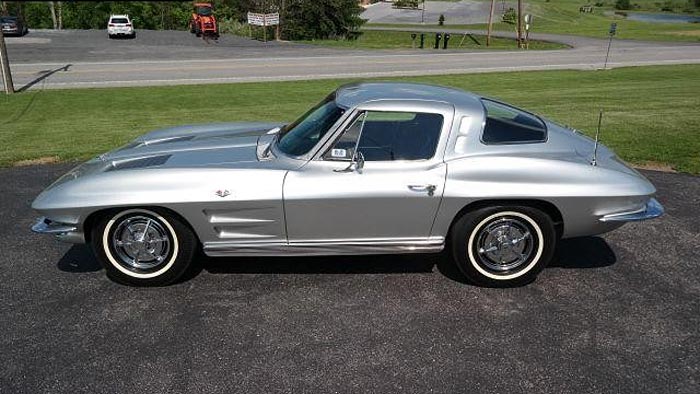
Was the Sebring Silver paint expensive? Adjusted for inflation, the $80.70 cost of the 1963 option would be $631.38 in 2015.
Along Comes Firemist
The very next year, 1964, GM introduced Firemist paint, which had a large-flake, borosilicate-based, pearl effect pigment. Cadillac used it first in 1964 on the Eldorado. Five colors were available.
In the early 1960s, the Engelhard Corporation of Iselin, New Jersey, developed and trademarked Firemist paint pigments. The flakes allowed light to reflect and refract through them, producing not only a bright glittery look to the paint, but also varied hues of the primary paint color. Because these flakes can reflect and refract light, Firemist is not a metallic paint, in the truest sense of the word. A true metallic paint contains tiny aluminum flakes that only reflect light.
Firemist paint continued to be used by GM divisions well into the 1990s.
In 1971 and 1972, Corvettes were available in three Firemist colors, Ontario Orange, Steel Cities Gray and War Bonnet Yellow. Corvette did not charge extra for Firemist colors:

This and more information about Corvette colors and color combinations can be found in the “All Corvette Colors” book series available at Amazon.com. Follow Robert Casey on twitter at @AllvetteColors.
Source:
All Corvette Colors
Related:
[PICS] C7 Corvette Stingray Serves as a Canvas in ART-of-Motion Exhibit
[PICS] C7 Corvette Z06 Is Repainted an Envious Green
2012 Corvette Begins Production Without Crystal Red and Cyber Gray
-

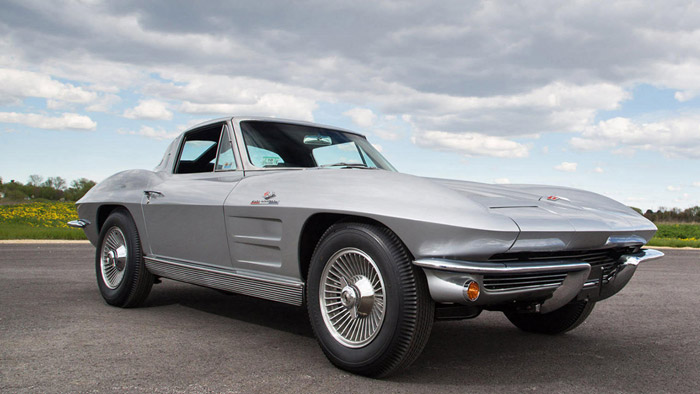
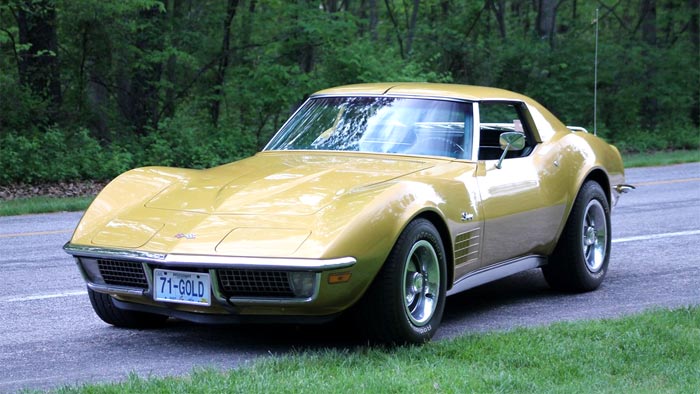
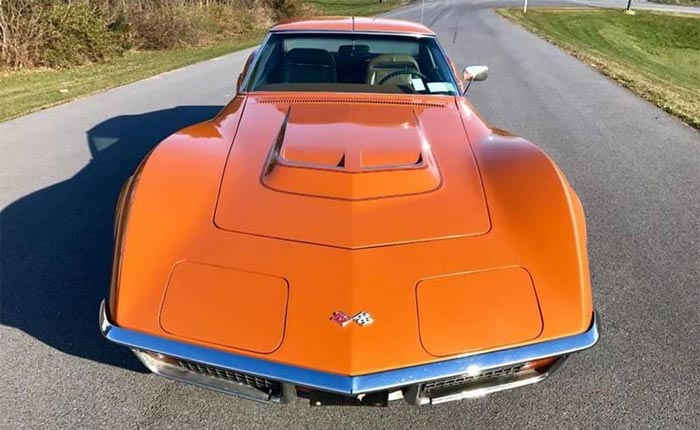
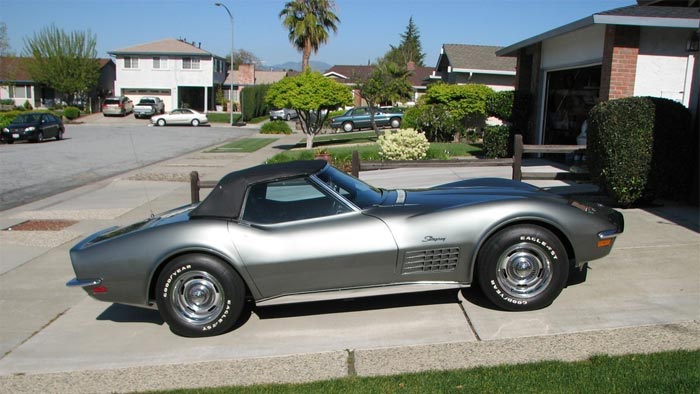
![[ACCIDENT] Canadian Driver of a Classic C3 Corvette Can’t See the Forest for the Trees [ACCIDENT] Canadian Driver of a Classic C3 Corvette Can't See the Forest for the Trees](https://www.corvetteblogger.com/images/content/uploads/2024/04/042324_17-218x150.jpg)

![[VIDEO] Dennis Collins Checks the Numbers on a 1970 Corvette LT-1 Before Taking It Home [VIDEO] Dennis Collins Checks the Numbers on a 1970 Corvette LT1 Before Taking It Home](https://www.corvetteblogger.com/images/content/uploads/2024/04/041724_1-218x150.jpg)
I had a 1971 LT1 coupe that I was told was Firemist Green. I bought it from a Chevy dealer (used 12,000). But it was not a repaint and I saw other vettes the same color. The paint had a metal flake look in it so what color was it?
Hi John,
The 1971 Corvette was available in a green color called Brands Hatch Green, which was only available that year. Paint manufacturer paint-chip charts indicate that this was not a Firemist color. There is a reason that Corvette offered only three Firemist colors, and a reason that the paint was offered only two years: The effect pigment (flake) was very big when compared to a metallic effect pigment (flake). So, at the factory, the paint booth spray nozzle would often get clogged. A larger spray nozzle was really required. That would slow down the painting schedule.
Your salesman likely did not know the name of the color. I see plenty of current Corvette ads where the color is a totally made-up name! Or, you may have had a Firemist repaint.
The only other possibility is that you truly had a Corvette in a special order color (even though you mentioned that you’ve seen other Corvettes in that color). However, Firemist colors were typically not approved for lines outside of Cadillac.
If you have photos of the driver door hinge area, the trim tag is there and will tell the story. Brands Hatch Green was code 983.
Hope this helped!
Best,
Robert Casey, author All Corvette Colors, available on Amazon
https://www.amazon.com/Robert-Casey/e/B01LWJZD4W/ref=dp_byline_cont_book_1
Perhaps Robert could be a color consultant for the Corvette division as the current offerings are limited.Yes, you need white, red, black, silver, yellow(?),but then you also need some “striking colors”…….like a deep slate blue metallic….and perhaps a color like spiral grey (with heavy metallic and a splash of silver/green in it)……and a deep navy blue (NOT PURPLE) with a tasteful amount of silver fine metalflake in it.Color affects our emotions, like Corvettes do….its about passion GM !
Hi Jon,
You are correct. There are times when the color choices on Corvette have been disheartening for those who want some pizzazz in their paint color! For example, for 2006-2008, only eight colors were offered in each of those three years. Once you get past the colors you mentioned – white, red, black, silver, yellow, and almost always dark red – only two color choices remained: Blue and Orange. However, those three years were a bit of an anomaly because Corvette typically offers ten color choices per model year.
I am hoping that the new addition to the Bowling Green assembly plant will solve our concerns. Wouldn’t it be great if Corvette was available in more than ten colors per year? How about fifteen? Or twenty? Or how about if we could get back to COPO-style ordering and get whatever GM color we wanted? We might have to pay for that one!
Best,
Robert Casey, author All Corvette Colors, available on Amazon
Robert – You already have to pay a premium for some of the color choices so this is nothing new in the C6 or C7 generations. I understand that this is a good option for seeking an exotic look, but I also believe that you should not have to pay extra for excitement! I agree with with Jon. The current color choices for the C7, like past interior/material choices for the C6, in my view, are substandard juxtaposed to the engineering and design of the car. If Corvette is to evoke “emotion” it seems to me that the colors should reach out and grab you rather than leaving one in a state of indecisive limbo between recurring stagnant color choices with that appear to be renamed on a yearly bases rather than reimagined. I vote for the later.
Hi Seth,
You are correct – extra cost paint was “nothing new” for C6 and C7 generations. Don’t forget that from 1999-2004, the C5 generation Corvette had extra cost colors, too. In fact, the C5 Corvette did something that all automotive manufacturers have done: If the extra cost color is available only on a special edition, the cost of that color is hidden in the cost of the special edition package. Which two C5 Corvette colors did that? Why were those two colors special?
However, the point of the article is that the Sebring Silver Fire Frost paint, an extra cost color, actually was “something new” for Corvette. It was not just “metallic.” It was Corvette’s first production color which included a “pearl” effect pigment.
I have been around Corvettes since the early 1980s and have never read anything about why that one 1963 Corvette color was extra cost, let alone the term Fire Frost. As far as I know, my books are the first to explain the reason for the extra cost on the 1963 Sebring Silver.
In the past, Corvettes paints had Fire Frost, Firemist, mica, and Afflair effect pigments. Can anyone explain the difference between those effect pigments? Today’s Corvette colors are made from a very different paint chemistry than pre-1981 colors and now finished with clearcoat. New paint will far outlast any of those old paints.
Corvette paint now contains effect pigments called Xirallic (several types have been used), Orange Flash (a lamellar pigment which was used in different Corvette colors), and various types of pearls, as well as multiple grades of lenticular metal flakes of varying tints. Further, since 1999 (C5 Gen), tint coats have been used – a very different paint application. These new effect pigments are very different than their predecessors, as is the paint application. Can anyone explain the difference between those new effect pigments? And, all of this is done within the strict limits of government mandated VOC regulations.
As far as any automotive manufacturer having an extra cost paint, you might equate it to bottles of wine: Some people pay $10 for a bottle, while some people pay $600 for a bottle. Both bottles look the same. Both bottles contain juice from a grape. The cost difference is in how that grape is handled.
Corvette simply calls some of their paint colors “metallic.” They are not.
That being said, and considering the paint department’s expansion at the Bowling Green plant, I too hope to soon see a wider range of super-cool Corvette paint colors!
Best,
Robert Casey, author All Corvette Colors, available on Amazon
Comments are closed.